Hellenic pagan discussing obscure Greco-Roman myths and theological elements
Don't wanna be here? Send us removal request.
Text
Greek myths: Tiresias
The half-divine son of Eueres and the nymph Chariclo, Tiresias is famous for his gifts of prophecy and his transformation into a woman. In Hellenic neo-paganism (Greek and Roman pantheons) he has become a queer icon.

Uncouth and harsh, Tiresias came across a pair of mating snakes and killed them, angering Hera. Snakes were associated with feminine divinities, as seen in the Minoan snake-goddess figurines excavated in 1903 at Knossos. As punishment for harming these sacred animals he was subsequently turned into a woman, and then blinded by Athena (who was associated with snakes through her aspect as Athena Parthenos).
For years the blind seer wandered from place to place, even getting married and having a daughter, Manto. Finally after being a priestess of Hera for seven years, Tiresia (as I affectionately call her) was turned back into Tiresias. But to "settle down" and have children would imply that this oracle had accepted their life, yes? Perhaps Tiresias-Tiresia was an early recorded instance of a genderfluid person in Greco-Roman tradition.
Either way, they have since taken on a new life in many queer Pagan circles. I personally invoke them along with Zeus, Ares, Summānus, Antinous, Quirinus and Hecate in my worship. In a mythic world so rich with non-gender-conforming and queer individuals, it always amazes me that there exist so-called pagans who insist on holding on to archaic notions of gender and sexuality, imposed largely by the conservative religions of the present era. Maybe if they actually studied their religion they could appreciate it for the inclusive and sophisticated rainbow it is.
1 note
·
View note
Text
Linguistics: Ancient Greek pronunciation
Modern Greek is a beautiful language with a rich cultural history. But to say Ancient Greek sounded the same as Modern Greek is to be dishonest, as much as saying Middle English and Contemporary English sound alike.
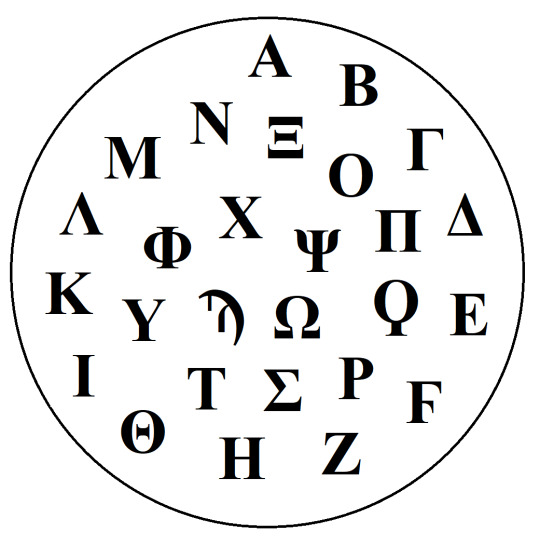
So what did Ancient Greek actually sound like? Well, we can reconstruct the pronunciation by comparing different written Greek dialects (such as Doric and Ionic), and seeing what grammarians of the time described the language as sounding like (such as the writings of Dionysius Thrax). We can also see loanwords in languages like Coptic to work our way back to an older mode of speech.
Alpha, Epsilon, Iota, Kappa, Lambda, Mu, Nu, Xi, Omicron, Pi, Rho, Tau, and Psi have all generally kept their Ancient pronunciations in Modern Greek.
The sounds that are different in Ancient Greek:
Β/β: like a "b" sound instead of Modern Greek "v." Basileus instead of Vasilevs.
Δ/δ: a hard "d" sound instead of Modern Greek soft "dh." Dolos instead of Dholos.
Γ/γ: like a "g" sound instead of Modern Greek "y"/"yh." Gunaika instead of Yineka.
Φ/φ: an aspirated "p" sound instead of an "f." Words like φῶς (phos) would have been pronounced like "p'os" instead of "fos."
Θ/θ: an aspirated "t" sound instead of a soft Modern "th" sound. Words like θάλασσα (thalassa) would have been "t'alassa" instead of "th'alassa."
Χ/χ: an aspirated "k" sound instead of Modern soft "ch." Words like χρυσός (khrusos) would have been pronounced like "k'rusos" instead of "chrisos."
Ζ/ζ: an "sd" sound that became "z" in Modern Greek. "Zeus" would have been pronounced as "Zdeus", with some dialects having "Dzeus."
Σ/σ: depending on the dialect a "z" sound instead of modern "s."
For vowels:
Αι/αι: as in German "Ein."
Αυ/αυ: as in German "Augen."
Ευ/ευ: an "ew" diphthong instead of "ev."
Ει/ει: a long "eh" sound, like in German "Ehrmann." Nelos (Νειλος) instead of Nilos (Νιλος).
Η/η: as in "ant" or "absolute." Hence the Doric spelling Σελάνα (Selana) for the usual Σελήνη (Selene), for example.
Υ/υ: as in German "über."
Οι/οι: as in "soy."
Ω/ω: a bit like the "aw" in English "raw."
There were also sounds like Digamma (Ϝ/ϝ), a "w" lost in many dialects, so words like ἄνασσα (anassa, "queen") were once ϝάνασσα (wanassa).
So the opening lines of the Iliad:
"Μῆνιν ἄειδε θεὰ Πηληϊάδεω Ἀχιλῆος
Οὐλομένην, ἣ μυρί᾽ Ἀχαιοῖς ἄλγε᾽ ἔθηκε,
Πολλὰς δ᾽ ἰφθίμους ψυχὰς Ἄϊδι προΐαψεν
Ἡρώων, αὐτοὺς δὲ ἑλώρια τεῦχε κύνεσσιν
Οἰωνοῖσί τε πᾶσι, Διὸς δ᾽ ἐτελείετο βουλή,
Ἐξ οὗ δὴ τὰ πρῶτα διαστήτην ἐρίσαντε
Ἀτρεΐδης τε ἄναξ ἀνδρῶν καὶ δῖος Ἀχιλλεύς."
Would be something like this in Ancient Greek (using a simplified transliteration):
"Mǣ-nin a-wē-de te-a Pæ-læ-i-a-deo A-ki-lǣ-os
Ū-lo-me-næn, hæ mu-ri A-kai-ois al-ge' e-tæ-ke,
Pol-las dip-tī-mūs psu-kas A-wi-di pro-i-ap-sen
Hæ-rō-ōn, au-tūs de he-lō-ri-a tew-ke ku-nes-sin
Oi-ō-noi-si te pā-si, Di-wos de-te-lē-e-to bū-læ,
Ex hū dæ ta prō-ta di-as-tǣ-tæn e-ri-san-te
A-tre-i-dæs te wa-nax an-drōn kai dī-wos Akill-ews."
9 notes
·
View notes
Text
Theory: The Allmother
To the Hindus she is Shakti, to Wiccans she is Herodias, to Heathens she is Frigg. In Hellenic Pagan and Roman Pagan communities she may be Cybele, Rhea, Gaia, Hera, Magna Mater, Tellus, Ops, or Juno.
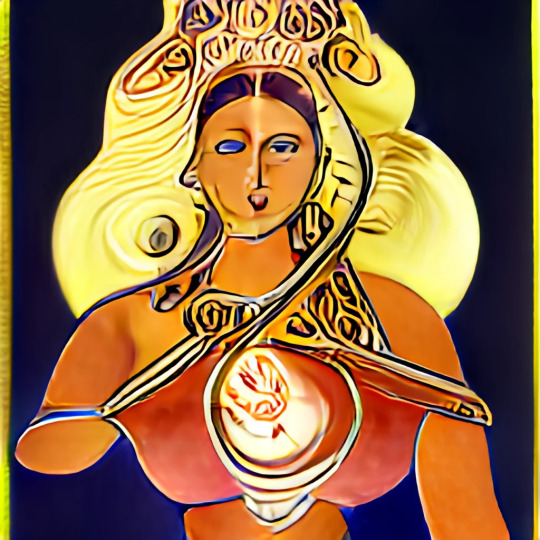
Regardless of her manifestation, this Allmother has found her way in many expressions of society irrespective of culture. Even the Avatar series has a Mother God (Eywa, a permutation of "Yawe").
Why did She appear? An easy explanation would be that fertility and creation were associated with femininity and motherhood, so a divine Genetrix was developed across different nations to express a common archetypal idea. But perhaps there is a more significant reason for Her presence.
Freud theorized that patricentric and androcentric religions arose as a result of tribes psychologically coping with the deaths of their patriarchs. Your paternal figure died? Deify him. Then he lives forever and will be with you in spirit. That was the idea, and younger deities like Zalmoxis (Ζάλμοξις) emerging from dead humans are evidence of this phenomenon.
I believe the Mother Goddess came about as a result of the brutality of early humanity. The first 200,000 years of our development were filled with bloodshed, killing by stronger predators, and natural disasters such as droughts. This violent contribution to our evolution meant that Young Humanity had little time for compassion or altruism. As a response to this excessive bestial cruelty, a "sacred feminine" was developed by various societies to cope with the evil that surrounded them.
This mechanism (if I may use such a crude term) has served its purpose in arising when societies are on the brink of collapse to steer people in the right direction. She was Sophia to the Valentinians and Mary to the Christians, but once patriarchal structures were enforced by greedy and power-hungry priests, this peace-producing principle was kept in the shadows and buried, resulting in humanity in general losing its capacity to love and sympathize and devolving into wars.
She is rising again, I believe in response to the god-awful state of so many countries. The spirit of revolution, of peace, of science, of ingenuity, of creative energy, of justice, is spreading her wings once more in the hearts of many. "Like the Star of Autumn who, surpassing all Lamps, is ever-shining, bathed in the ocean", to quote Homer.
And we are left with two options: move with Her, or get out of the way.
5 notes
·
View notes
Text
Hellenic religion: Etruscan incorporation
The Etruscans were the indigenous people of ancient Italy, living in areas like Tuscany (from where the region gets its name). Their language was an isolate, their culture pre-Hellenic and pre-Roman, and their religion greatly influenced Greco-Roman practices.

For one, their central gods (aisar) can be matched to the Greek and Roman pantheons one for one. Uni, Ethausva, Menerva, Zerene, Artume, Turan, Laran, Turms, Tinia, Nethuns, Sethlans, Rath, Fufluns and Aita parallel with Hera, Hestia, Athena, Demeter, Artemis, Aphrodite, Ares, Hermes, Zeus, Poseidon, Hephaestus, Apollo, Dionysus and Hades. In the case of Greco-Roman religion, Artemis and Neptune (Poseidon) may have been borrowed from their Etruscan counterparts (Artume and Nethuns).
A possibly older pantheon of sixteen heavenly rulers seems evident based on Etruscan astrology: Tinia, Thufultha, Thneth, Uni, Tekum, Lusa, Nethuns, Katha, Fufluns, Selvans, Letham, Tlusku, Kelsklan, Kulsans, Veioves and Kilens.
Their notion of Summanus (god of nocturnal thunder) may have influenced Pluto and Hades, and their Etrusca Disciplina (a body of religious texts now lost to time) appears to have influenced animal-based divination in Roman religion (such as the use of birds and frogs to discern omens).
While their language is no longer spoken and their religion gone, the Etruscans left behind an imprint of indigenous Italian culture through their assimilation into the Roman world.
7 notes
·
View notes
Text
Greek myths: POC in the Legends
It's typical to find some ethnocentric Hellenic pagans insistent on the general lack of colour in their religion. The stories take place across the Greek islands and Italy, so obviously there can only be white heroes and gods in the myths, right? Perhaps it's time for these folks to have a history lesson.

The vague boundaries of Ancient Greece stretched, at the very least, from Macedonia to Rhodes, and housed hundreds of states, towns, cities and villages. Many of these settlements were close to continents such as Africa, where the Egyptians and Carthaginians (a Punic nation) lived. Apart from them, the Greeks and Romans also knew of and traded with the "Ethiopians" (Αἰθίοπες), which was a general term referring to Black people (from Αἴθω + Ὤψ, "Dark Face"). This closeness of different ethnicities meant that there would be some diversity of religious figures by virtue of cultural exchange.
Memnon (Μέμνων) was the demigod son of Tithonus and the goddess Eos, and was the king of Ethiopia. There was also his brother Emathion (Ἠμαθίων) who fought Heracles. Eurybates (Εὐρυβάτης) was Odysseus' "dark-skinned" (μελανόχροος) companion, and was honoured by him above his other comrades (Odyssey 19, Lines 246-249).
And to use a more well-known example: Andromeda (Ἀνδρομέδα), wife of Perseus, was the daughter of Cepheus and Cassiopeia, king and queen of Ethiopia. The legendary woman more beautiful than Aphrodite was Black. She and Perseus may also be one of the earliest examples of an interracial union in the Greek stories.
And to those who would object and say these figures are represented as white in sculptures and wall paintings, the divergence from the original textual sources is a simple result of interpretatio graeca. People will often render foreign persons or deities through the appearance and mannerisms of their own nation (e.g. old paintings of Jesus in Ethiopia and China showing him to be Ethiopian or Chinese), and in this case Black characters were filtered through a Greek and Roman lens.
The ancient Greeks and Romans saw skin colour as a designation of one's national origin, but not as a racial identifier. If you approached a Roman and told him the vikings were of the same "race" as him, he would be deeply offended. "Race" was formulated by European pseudoscientists in the 15th to 16th centuries to justify the barbaric things that were done to enslaved Africans, Indigenous peoples in the Americas, and later South Asians.
I as a white person am wholly comfortable, and also appreciative, of the presence of people of colour in my religion. They serve as a reminder of the universality of attributes such as heroism, strength, kindness, courage and valour. Virtue is not bound to one skin colour, and we are all fundamentally one race: the Human Race.
So don't let these pseudadelphoi (false siblings) stir discord and disunity in our communities. All are welcome in the Faith and to the graces of the gods, regardless of colour, sexuality, or gender identity.
8 notes
·
View notes
Text
Greco-Roman cults: Mithraism
Mithraism is an interesting case of a foreign deity being wholly incorporated into Greco-Roman culture. We see examples of this in hybrid gods like Hermanubis (Ἑρμανοῦβις), but the cult of Mithras would assume influence these prior sects had never dreamed of.

Mithra is an ancient Iranian divine being (yazata) with a thousand ears and ten thousand eyes, associated with light, the Sun, justice and oaths. His name in Greek (Μειθρας) is numerically 365, the number of days in the year, associating him with the spheres of the heavens much like the archon Abrasax (Ἀβρασάξ) was.
Further connecting Mithras with the celestial spheres, the religion of Mithraism had seven ranks of initiation one could progress up:
Corax (Κόραξ): the Crow, associated with Mercury.
Nymphius (Νυμφίος): the Bridegroom, associated with Venus.
Stratiotes (Στρατιώτης): the Soldier, associated with Mars.
Leon (Λέων): the Lion, associated with Jupiter.
Perses (Πέρσης): the Persian, associated with Luna.
Heliodromus (Ἡλιοδρόμος): the Sun-Runner, associated with Sol.
Pater (Πατήρ): the Father, associated with Saturn.
The cult had many esoteric astrological symbols associated with its practice, most notably the Sacred Bull:
In each Mithraeum (Mithraic temple) there is an image of a white bull (Taurus) being slain by Mithras (Leo) wearing a Phrygian cap, who kneels on the animal with his right foot holding down the bull's right hind hoof and his left knee resting on the bull's back. He slays it with his right hand, holding it by the nostrils with the other, looking over his shoulder to face the sun on the left, and a dog (Canis major) and snake (Serpens) reach up to strike the bull. A scorpion (Scorpius) seizes the bull's member. A crow (Corvus) is flying around the bull. Three ears of wheat (Spica) emerge from the bull's wound. Two torch-bearers (Gemini) stand on either side: Cautēs (Καυτής, "Stone") with his torch pointing up and Cautopatēs (Καυτοπατής, "Stone of Opening") with his torch pointing down. The moon is on the right, parallel to the sun.
This layered symbolism required secrecy to remain obscure to the uninitiated, and as such Mithraism was an underground religion with select members, mostly military. During the Christian period many Roman soldiers would join the Mithraic religion, seeing Mithras and Yeshua as one and the same, with stories from the era claiming that Mithraists practiced baptisms and bread-and-wine communion. The religion eventually faded away from a lack of textual preservation and shrinking converts, though many of its Mithraea still remain. Judging by its size at its peak, it would have rivalled Christianity and may have even replaced it as the dominant faith in another timeline.
21 notes
·
View notes
Text
Paganism: Hellenic Atheists
Early humans saw the beauty of nature, the spectacle of the cosmos, and concluded that there was some element of design to its systematic structure and diversity. They called these designers theoi, elohim, devas, orisha, dei, aesir. But among these communities there were those sceptics who interpreted the gods as more metaphorical than literal.
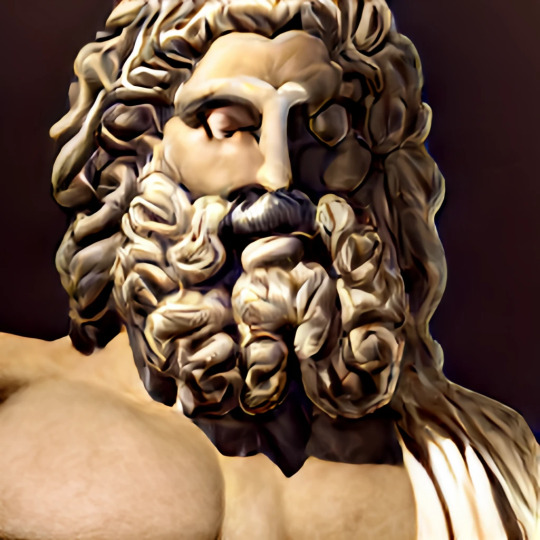
The Atomists in ancient Greece believed the world was purely material, with the gods representing natural phenomena or at least not being as people perceived them. Philosophers like Diagoras and Epicurus were agnostic about the gods' existence, and attempted to steer people away from unhealthy superstitions and harmful dogmatism.
This nuance of thought seems to be under attack in many Heathen and Pagan communities, with some literalist devotees of the faiths insisting that the gods MUST be literal beings involved in human affairs, or at least abstract entities who can influence the world in some way.
The way I see it, paganism has ways to solve the problem of evil in ways monotheism usually can't. Monotheists would argue that their "God" is omnipotent, omniscient, omnispective, and omnibenevolent, but the state of our world would bring into question any one of those attributes.
To use an ancient argument:
"If God wants to prevent evil, but is not able to, They are not all-powerful. If They are able to, but not willing, They are evil. If They are able to and willing, why allow evil? And if They are neither able to nor willing, why call them God?"
But pagans and heathens usually don't consider their gods to have omni-attributes. The reason there is evil is because the gods permit it. Why? Sometimes the gods do good things, sometimes bad things. Like people.
So a pagan/heathen could be comfortable in their belief because it does not require any major moral arguments like that of the monotheists' beliefs. But there is still the requirement of evidence for the gods' existence, if not their morality.
So in many neo-pagan communities it is common to find atheistic or agnostic believers, those who see the gods as reflected in humanity and our potential to surpass our physical limits. I myself am open to the idea that the gods are very real beings who can engage in exchange-based relations with humans. We offer them things, they can offer us things, the balance is maintained.
And if these gods exist, then atheists need not worry about the afterlife. If you lived righteously, ethically, and with the interests of others at heart, they will judge you accordingly. Unlike the monotheists, we need not fear for our salvation.
But the nuance needs to remain. Freedom of thought needs to remain within our communities, even the thoughts of "godless" believers. The only ideas that should be condemned and rejected are racist, sexist, homophobic, transphobic and generally discriminatory beliefs based on outdated traditions and pseudoscience. Reason and faith can coexist so long as faith is based on reason.
4 notes
·
View notes
Text
Greek myths: The Five Ages
Hindu scriptures have the Four Yugas, Christian texts the Six Dispensations. But to the ancient Greeks five Ages were how they divided human history, with each Age serving a literal and symbolic purpose.

Hesiod in his Works and Days (c. 700 BCE) lays out each era with its notable features, including the nature of human beings during this time:
The Golden Age (Χρύσεον Γένος): the age during which Cronus ruled Olympus and the universe with the Titans. Humans in this time were no different from the gods, apart from their mortality which was peaceful and painless. When these long-lived "golden" humans died, they would return as Pure Daemons (Δαίμονες Ἁγνοὶ), dwelling in the sky as benevolent spirits and blessing the agriculture of the living.
The Silver Age (Αργυρόν Γένος): the age during which Zeus assumed power. A child in this age would live a hundred years before becoming an adult, and adults lived for a short time. They were less intelligent, less altruistic, and were spiteful of the gods, leading to the Sky Father gradually wiping them out. Upon death they would become Blessed Mortals on the Earth (Ὑποχθόνιοι Μάκαρες Θνητοῖς), dwelling on the ground while the Daemons lived in the skies.
The Bronze Age (Χάλκειον Γένος): a violent and war-centred humanity who loved the ways of Ares more than any other god. They were the first to begin using bronze weapons and equipment, and destroyed themselves without divine intervention, leaving no name behind them and not returning as divine beings upon death, remaining trapped in the Cold House of Freezing Hades (Εὐρώεντα Δόμον Κρυεροῦ Αίδαο).
The Age of Heroes (Ἀνδρῶν Ἡρώων Θεῖον Γένος): the Heroic Age was an improvement from the prior era. This was the age of Hemitheoi (Ἡμίθεοι, "Demigods"), the Deific Heroes such as Heracles and Achilles. Upon death they would go to Elysium (Ἠλύσιον), an afterlife for the righteous ruled by Cronus.
The Iron Age (Σιδήρεον Γένος): our current era. People live for incredibly short times, are more susceptible to greed, and all mortal divine beings are long dead.
The symbolic meanings of these ages could be applied to our biology: humanity beginning as innocent apes (Golden Age: Hominoidea), becoming more advanced and developing language (Silver Age: Hominidae), evolving more advanced brains and developing tools (Bronze Age: Homininae), developing cultures and civilizations (Heroic Age: Hominini), and progressing into modern humans (Iron Age: Hominina).
1 note
·
View note
Text
Greek myths: The Triple Goddess
The concept of a tripartite (three-formed) deity is not exclusive to Greco-Roman religion. Hinduism has the Tridevī (Sarasvatī, Lakshmī and Pārvatī), and in Celtic mythology we find the Mórríoghain (Éire, Fódhla and Banbha). To the ancient Greeks and Romans, the Triple Goddess appears to have been an element of their faith since the beginning of their civilizations.

In the Mycenaean civilization we find evidence of a divinity called Potinia ("The Lady"), in later Greek Potnia (Πότνια), who had a sibling known as Core (Κόρη), the "Maiden", later identified with Persephone. They had a mother, said to be Demeter (Mycenaean Greek: Damater), and the three were often worshipped as one unit sometimes identified with Hecate depending on the tradition. My personal theory is that Potnia is actually Hecate, since the Lady's name is meant to be unrecorded by her devotees and "Potnia" is merely a title.
Tripartite goddesses are prevalent in the Roman texts. The Horae (Thallo, Auxo, Carpo), Charites (Aglaea, Thalea, Euphrosyne), Moerae (Clotho, Lachesis, Atropus) and other triads of goddesses taken from the Greek myths can be interpreted as a single divine being split into three aspects: the Maiden who represents youth and vitality, the Mother who represents life and creation, and the Crone who represents age and wisdom. The most common Roman aspect of the Triple Goddess was the "Diva Triformis" (Lūna, Lībera, Dīāna) drawn from local pre-Hellenic Latin deities.
The presence of the Triple Goddess demonstrates the earlier importance women held in Greco-Roman society before the greed and selfishness of powerful religious clergy relegated these ancient traditions to the sidelines. The idea of a supreme Creatrix is not a new concept to Hellenic and Roman religion, and the reviving of Goddess worship among many neo-pagan groups should not come as a surprise to those well-versed in the faith. It is a reclamation of an older heritage, not simply a response to the culture of the time.
And with that in mind, I'm glad to see the Divine Feminine revealing Her familiar face once more. When women are uplifted, we are all uplifted.
6 notes
·
View notes
Text
Greek myths: The Son That Never Was
In the Theogony (Lines 897-898) Hesiod makes an interesting statement often overlooked, one of the Son That Never Was.

For some context, Greek ruling gods are often displaced by their children, and them by their children in a way matching human monarchs. The pattern started with Uranus being overthrown by Cronus, and then Cronus being overthrown by Zeus.
In Hesiod's poem a prophecy is said of two children being born to the titanide ocean nymph Metis, Goddess of Wisdom, the first wife of the Sky Father: a daughter wiser than her mother, and a son who would overthrow Zeus and become the new ruler of Olympus. The idea of this mysterious 'Pais Basileus Theon kai Andron' (Child-King of Gods and Humans) terrified Zeus to the point where he absorbed Metis into himself to prevent the birth of this usurping son, in the process acquiring some of Metis' wisdom and giving birth to Athena, wisest of the gods, from his mind.
The potential Son never was, and he is given no name in the Theogony, but to afford him some textual dignity I will call him "Hyperbius", on account of his "overwhelming" ("huperbios") heart as described by Hesiod. Had Hyperbius been born, he would be the new Autocrator to whom the gods and goddesses prostrate until his own child replaced him. But the ad-infinitum pattern of succession is stopped at Zeus.
Had the Greeks worshipped a Sky Lord who was never the same for more than a generation, the belief system as a whole would have been unsustainable and eventually collapsed. But I believe there is a deeper symbolic meaning behind Hesiod thematically making Zeus the final ruler of the gods.
Uranus (Οὐρανός) literally means "sky" or "heaven" (in the sense of a "celestial expanse"). The void of Space, filled with stars being born and dying stars waiting to beget new supernal lights. Cronus (Κρόνος) is related to the Greek word Χρόνος (Time), although this 'Chronus' is said to be a separate deity to the Titan King in some traditions. Zeus (Ζεύς) stems from Proto-Indo-European "deywós" ("deity") in the sense of a physical sentient manifestation of the sky ("dyew" in P.I.E)
The three primary universal constituents are reflected (at least subtextually) within Hesiod's poem, with Zeus being the representation of Matter. He is bound to the physical realm, with a home on a Greek mountain and powers centred around phenomena in nature (thunder, lightning, rain, etc.)
Hyperbius would represent a transcendence of the natural world by being a fourth element separate from the fundamental three. His exclusion from the Theogony, a central text that standardized much of Hellenic mythos, can be interpreted as an implicit statement regarding Greco-Roman religion itself: It is all within Nature.
All the deities of the religion are nuanced and up to a variety of interpretations. To some they are literal beings who can intervene in human affairs, to others they are simply allegorical archetypes of human concepts such as rulership and authority. As an Epicurean I will simply say this: if the gods exist, they are not as interested in our world as we are in theirs.
Should they exist in nature, this is yet another reason to preserve our planet (apart from the ultimate reason: it's our only home and we should keep it preserved for future generations). If the gods dwell within our world, then we are custodians of their bounty, and Humanity is metaphorically the fourth ruler of the gods, the Child Who Can Be.
4 notes
·
View notes
Text
Greek myths: Sminthus and Cassiterus
The ingenuity of Greco-Roman folk tales is that they often preserve older rural myths when the images and texts of such stories are either lost to time or re-adapted to a newer religious context.

Take the Mycenaean war-deity Enuwalios, who was absorbed into the mythology of Ares to produce the local form of "Ares Enyalius" (Ἄρης Ἐνυάλιος) who assisted warriors and soldiers. The old myths surrounding Enyalius may have been lost to history, but he found a new mythos and life as a god reborn. In the case of Sminthus and Cassiterus, we see an older mythological stratum absorbed into an expanding Greco-Roman theological framework.
Sminthus (Σμίνθος) was a minor deity worshipped in northwestern Anatolia, and was, for lack of a better term, the "god of mice." Mice were considered sacred as they often lived under altars to eat the food offered to local deities, abiding constantly in the presence of the divine. In India we find Mūshika and Ganesha, in Mesopotamia "Nin-Kilim" (the "Mouse Lord"). Mice were also considered disease-bringers, and were worshipped by humans seeking shelter from pestilence (like people worshipping Poseidon to avoid earthquakes).
Sminthus appears to have been later absorbed into Apollonian tales, as seen in "Apollo Smintheus" (Ἀπόλλων Σμινθεύς) being worshipped in Hamaxitos. This "Sminthian Apollo" was even invoked in the Iliad by Chryses to smite the Greeks for his daughter's kidnapping (Book I, Line 39). In some of the re-imagined sources Sminthus is the son of Apollo and an unnamed human woman, making him a demigod like Aristaeus or Asclepius.
Cassiterus was a shepherd from a mortal family of no repute. His name (Κασσίτερος) means "Tin", and may have connected him to the earth metals as a chthonic deity in an older dispensation. Either way, this human and this god would find themselves caught in Aphrodite's rosy net.
Like Apollo and Admetus, Sminthus found himself ardently devoted to Cassiterus, whom he doted on and bestowed with gifts. The two were intertwined like the staff of Hermes, and were inseparable until Morus struck with his hateful spear.
While Sminthus was away, Cassiterus attempted to protect his flock from a band of travelling Trojans looking for food and a place to build a new settlement. He was mortally wounded in the process.
In a divine rage, Sminthus sent a swarm of field mice to eat the leather of their items, and would have struck them with plagues as well had his father not intervened. Apollo made a petition to the Sky Father for help, and Zeus offered to make the site of Cassiterus' death sacred for all generations.
Upset that he refused to save him in some way, Sminthus knelt on the ground with his dying partner in his arms, and let his tears mingle with the spilt blood. At the place where tears and blood, love and death, came together, a plant grew. Life for a life. And so they were separated, but never divided. One to be assimilated into his more famous father's mythology, and the other to fade into time, but never from his lover's heart.
3 notes
·
View notes
Text
Greek myths: The Coenonus (Koinonos)
The gods had many lovers, but only a select number of koinonoi. Lovers could be lost, but they could not.
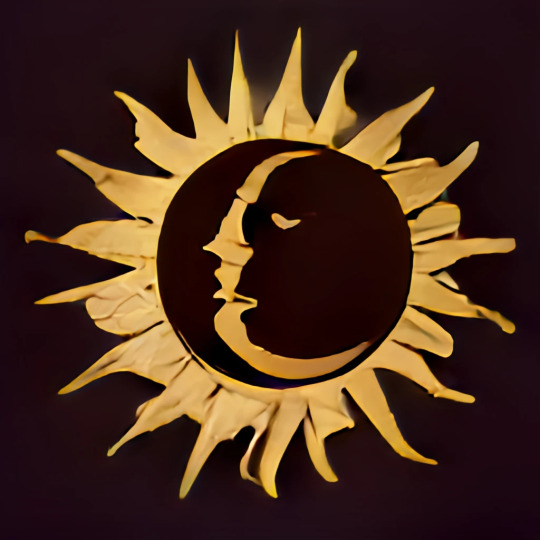
Coenonus (Κοινωνός) can be translated as "partner", "companion", or "partaker", but in the case of the gods usually has an intimate dimension as "consort." Often a consort of a sexual nature, one's coenonus was closer than one's lovers for the simple reason that lovers helped you find the elements that gave you "completion", but coenoni actually completed you.
Zeus had many wives, but only one coenonus: Hera. Aphrodite may have been married to Hephaestus, but her coenonus was Ares. Hades had Persephone, Poseidon had Amphitrite, and so on. Divine pairings have been common in Greco-Roman traditions since the inception of their civilizations. Even human rulers had "soul-partners", such as Hadrian with Antinous. And, infamously, Maryam of Magdala (מרים המגדלית) is said to be the koinonos of Yeshua of Nazareth in the extracanonical Gospel of Philip.
In modern times we have ideas of "soul-mates" and "The One" who would be the perfect partner. The presence of coenoni in the Ancient world reminds us that the ancient Greeks and Romans were living, breathing people with real desires and hopes for love, as we are, and that (minus the technological and scientific innovations) we haven't changed much fundamentally, at least in terms of our capacity to love and be loved.
5 notes
·
View notes
Text
Greek myths: The Lords of the Gigantes
The giants (γίγαντες) were Gaia's children, and can be considered her last stand against the Olympians before she unleashed Typhon on the gods.
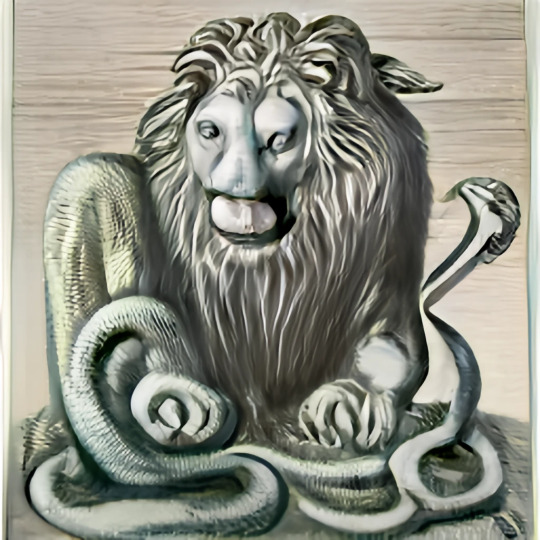
They were lion-headed anguiped humans, having hissing snakes in place of legs. As strong as the Titans, they too were overthrown by the might of Zeus and his children.
What interests me most about the story of the Gigantomachy (Giant War) is the record of giant "lords" who led their brethren into battle. Each is matched to an Olympian, as the Titans are matched to their successors:
Eurymedon (Εὐρυμέδων): the king of the giants and rival of Zeus. He was also called Porphyrion (Πορφυρίων). Killed by Hera.
Agrius (Ἄγριος) and Thoas (Θόας): killed by the Moerae who fought on behalf of Hades.
Polybotes (Πολυβώτης): killed by Poseidon.
Clytius (Κλυτίος): killed by Hecate who fought on behalf of Demeter and Hestia.
Enceladus (Ἐγκέλαδος): killed by Athena. The record says she also killed a giant named Pallas, but Pallas was a Titan in the prior Titanomachy (Titan War) and this element appears to be a later interpolation.
Mimas (Μίμας): killed by Hephaestus.
Pelorus (Πέλωρος): killed by Ares who fought on behalf of Aphrodite.
Ephialtes (Ἐφιάλτης): killed by Apollo.
Aegaeon (Αἰγαίων): killed by Artemis.
Hippolytus (Ἱππόλυτος): killed by Hermes.
Eurytus (Εὔρυτος): killed by Dionysus.
There is also mention of an "Alcyoneus" (Ἀλκυονεύς) killed by Heracles, but this appears to be a later addition. Alcyoneus is described as immortal so long as he remained in his homeland, similar to Antaeus (Ἀνταῖος) a son of Poseidon and Gaia who was invincible so long as his feet stayed in contact with the ground. Antaeus was also killed by Heracles during his Twelve Labours, so it seems that they are the same person.
3 notes
·
View notes
Text
Theory: The name "Sabazios"
The Phrygians were a nation that interacted with the ancient Greeks from at least the 7th century BCE. Being an Indo-European group, their mythology matches Greek and Roman pantheons almost one-for-one. A notable example is Sabazius (Σαβάζιος), their paternal sky-god associated with horses and lightning.
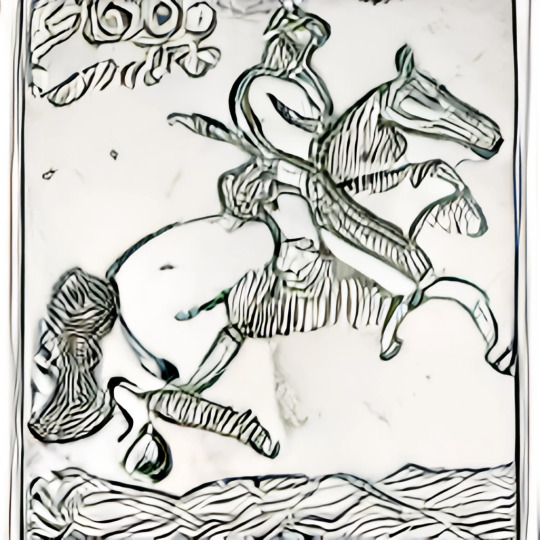
Sabazius was considered by some to be the son of Kubeleya (Cybele)
The name Sabazius has an uncertain etymology. It's assumedly a Hellenized form of a Phrygian name, but knowledge of the Phrygian language is limited due to its scarce attestation. I have a theory of where the name may come from based on sound changes and comparative mythology.
Firstly, the symbols associated with Sabazius (clouds, horses, thunder, the heavens) link him with various other Indo-European chief gods (Perkūnas, Deipatura, Dyaush, etc.) so his name may stem from a common Proto-Indo-European term for "deity." Usually the chief god of an Indo-European pantheon has no personal name, but is instead referred to with a title and an honorific (e.g. "Sky Father", "All Father", "King of the Gods") and "Sabazius" may be no different.
The element Ζιος seems to come from an earlier Ziwos (Ζιϝος), which ultimately stems from Proto-Indo-European "Deywós" ("God", "Divine Being"), the root of names like "Zeus" and "Iūpiter." So without much resistance we could assume a part of Sabazius' name means "-god."
"Saba" is the challenging bit. It may stem from a native Phrygian word, but when written in the Greek alphabet its original form might have been obscured (older texts render it as "Σεβα"). It may be related to the verb "σέβομαι" ("to be in awe/admiration"), making Saba-Zios' name "The Venerable God" (fitting the deity's role), the usual scholarly conclusion.
I personally think the "saba" element may be related to the Semitic element "ṣaba" ("army"), hence "God of Armies", as Sabazius was associated with Dionysus (see Aristophanes' The Wasps) and Dionysus had an army of devoted maenads. But I guess the beauty of Greek myths is that we may never have the full set-in-stone picture, allowing for the mythology to be truly alive for each new generation.
3 notes
·
View notes